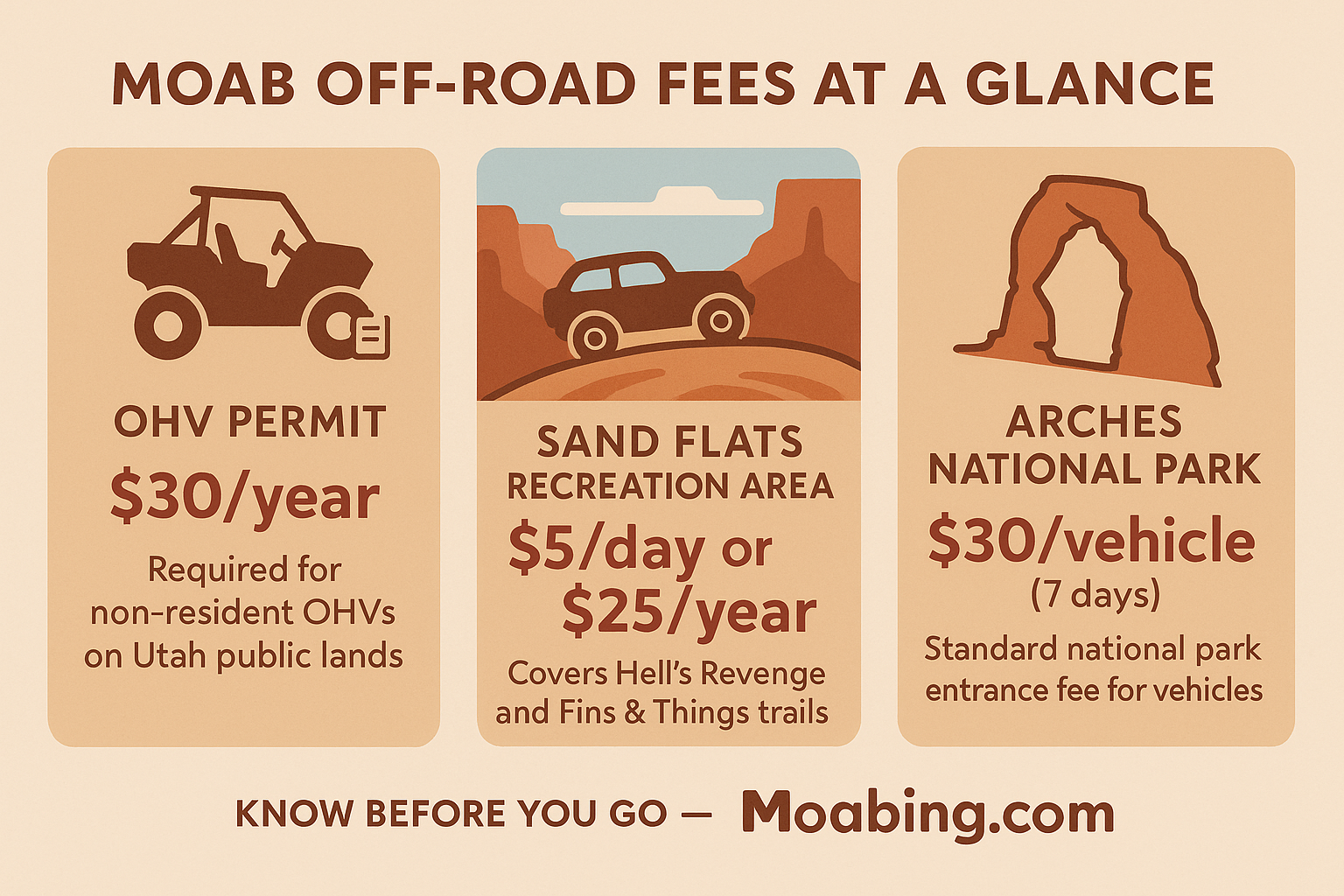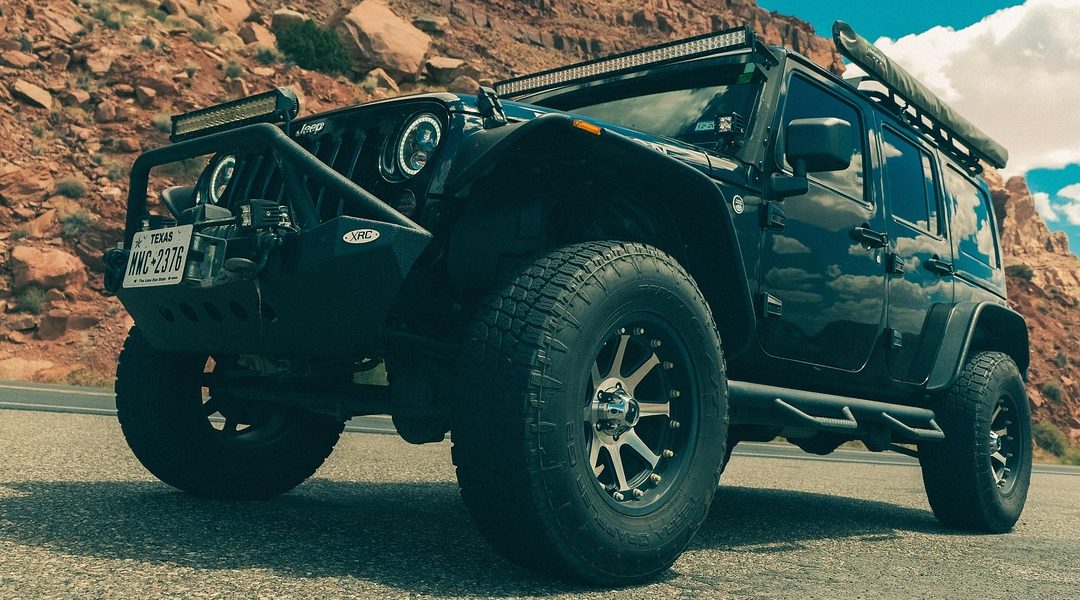Is There a Fee to Off Road in Moab? Permit & Fee Guide
Moab is one of the most famous off-roading destinations in the United States, drawing Jeep owners, ATV enthusiasts, and UTV groups from around the world. Before you load your rig and hit the red rock, one question comes up again and again: Is there a fee to off road in Moab?
The short answer is sometimes. Depending on where you go and what you drive, certain areas require permits or entrance fees. Others are completely free. This guide explains off-roading fees in the Moab area, how to get the right permits, and what to expect when exploring Moab’s legendary trails.
Quick Facts: Off-Roading Fees in Moab
| Type of Vehicle or Access | Where It Applies | Fee or Permit Required | Cost | Duration |
|---|---|---|---|---|
| Standard Vehicle | Arches & Canyonlands National Parks | Park Entrance Fee | $30 per vehicle | 7 days |
| OHV / ATV / UTV (Non-Resident) | Utah Public Lands (BLM, State Lands) | Non-Resident OHV Permit | $30 | 12 months |
| OHV / ATV / UTV (Utah Resident) | Utah Public Lands | State Registration | Varies | Annual |
| Sand Flats Recreation Area (Hell’s Revenge, Fins & Things) | County-Managed Area | Recreation Fee | $5/day or $25/year | As listed |
| Guided Off-Road Tours | Various Trails | Tour Company Fee | $120–$250 per person | Per trip |
Key Takeaway:
Most off-road visitors only need a $30 non-resident OHV permit or a Sand Flats day pass. Park entrance fees apply only if your route enters Arches or Canyonlands.
Understanding Moab’s Off-Road Fee System
Moab’s landscape is managed by several agencies, each with its own rules. Fees depend on whether you’re on federal, state, or county-managed land.
-
National Parks: Arches and Canyonlands require standard vehicle entrance fees.
-
BLM Lands: Most Bureau of Land Management trails (such as Sevenmile Rim or Gemini Bridges) are free, but your machine must display a current OHV permit if it’s not street-legal.
-
Sand Flats Recreation Area: Managed by Grand County and the BLM, this area includes the iconic Hell’s Revenge and Fins & Things trails. You’ll need a $5 daily or $25 annual pass.
-
City of Moab: Off-highway vehicles can operate on designated city streets if they’re street-legal, obeying posted speed limits and local noise regulations.
Key Takeaway:
Where you drive determines what you pay. BLM trails are mostly free, but county and park lands have fees. Always check posted signage or agency websites before entering.
Do You Need a Permit to Off Road in Moab?
Yes, if you are driving a non-resident ATV, UTV, or dirt bike on public land in Utah, you must purchase a Non-Resident OHV Permit. These are required for any machine that is not street-licensed in Utah.
How to Get an OHV Permit
-
Online through the Utah Division of Outdoor Recreation (recreation.utah.gov)
-
At select Moab vendors including Maverik, Canyonlands Jeep Rentals, and the Sand Flats entrance station.
Permits cost $30 and are valid for 12 months. Each vehicle must display the permit decal.
Key Takeaway:
All non-resident OHVs need an active Utah permit before operating on public trails.
Free and Paid Off-Roading Areas Around Moab
| Area | Managing Agency | Fee Required | Typical Vehicle Types | Notes |
|---|---|---|---|---|
| Sevenmile Rim | BLM | No | 4×4, UTV | Moderate technical terrain with classic views |
| Gemini Bridges | BLM | No | 4×4, UTV | Family-friendly, connects to Metal Masher |
| Sand Flats Recreation Area | County / BLM | Yes ($5/day) | 4×4, ATV, UTV | Includes Hell’s Revenge and Fins & Things |
| White Rim Road (Canyonlands NP) | NPS | Yes (park fee + permit) | 4×4 | 100-mile backcountry route; day or overnight permits |
| Arches National Park Roads | NPS | Yes ($30/vehicle) | SUV, 4×4 | Paved roads only, no true off-roading |
| Dalton Wells Area | BLM | No | 4×4, UTV | Free dispersed riding north of Moab |
Key Takeaway:
Many of Moab’s trails remain free thanks to BLM management. The main exceptions are Sand Flats and National Parks.

When to Go Off-Roading in Moab
Moab’s off-road season lasts nearly year-round, but conditions vary dramatically by season.
| Season | Conditions | Notes |
|---|---|---|
| Spring (Mar–May) | Ideal weather, busy season | Trails are open and dry |
| Summer (Jun–Aug) | Very hot; over 100°F common | Ride mornings or evenings |
| Fall (Sep–Oct) | Cooler temps, fewer crowds | Prime riding season |
| Winter (Nov–Feb) | Occasional snow or ice | Some trails limited |
Pro Tip:
Spring and fall offer the best mix of trail accessibility, comfort, and daylight.
Key Takeaway:
Visit in April–May or September–October for the best conditions and moderate temperatures.
Safety, Preparation, and Responsible Use
Even experienced off-roaders underestimate how remote Moab can feel once you leave the highway. Come prepared.
Essentials Checklist
-
Valid permit or park pass
-
Vehicle recovery gear and tire repair kit
-
Minimum 1 gallon of water per person per day
-
GPS navigation or offline map
-
Hat, sunscreen, and sunglasses
-
First-aid kit
-
Communication device (cell coverage is unreliable outside town)
Responsible Riding Practices
-
Stay on marked routes to protect fragile soil and vegetation
-
Avoid wet or muddy trails to reduce erosion
-
Pack out all trash
-
Respect sound ordinances within city limits (especially for UTVs)
Key Takeaway:
Preparation and respect for the environment ensure Moab’s off-road areas stay open for everyone.
What to Expect on Moab’s Popular Trails
Hell’s Revenge and Fins & Things
Both located inside the Sand Flats Recreation Area, these trails define Moab’s off-roading scene. Expect steep slickrock climbs, dramatic ridgelines, and canyon overlooks. The area is open year-round with a $5 daily or $25 annual pass available on-site.
Gemini Bridges
A scenic route through BLM land north of town. Moderate difficulty, suitable for SUVs and side-by-sides. No day-use fee, but OHV permits are required for non-residents.
White Rim Road
Inside Canyonlands National Park. A multi-day backcountry route that requires a day-use or overnight permit plus the park entrance fee. Highly regulated due to fragile desert ecosystems.
Key Takeaway:
Sand Flats is the only major fee area, while most BLM trails remain free with proper permits.
FAQs: Off-Roading Fees in Moab
Do I need to pay a fee if I bring my own UTV?
Yes, if it’s not street-licensed in Utah. You must buy a $30 non-resident OHV permit valid for 12 months.
Is there a separate charge to drive into Sand Flats?
Yes, $5 per day or $25 for an annual pass per vehicle.
Can I drive my UTV into Arches National Park?
No. Arches and Canyonlands allow only street-legal vehicles on paved roads.
Are there discounts for locals or multi-day visits?
Local residents can buy annual passes for Sand Flats. Non-resident OHV permits are flat rate per machine.
Where can I buy permits in person?
At Maverik gas station, the Sand Flats entrance booth, Canyonlands Jeep Rentals, and other authorized vendors.
What happens if I off-road without a permit?
You can receive a citation from BLM or local law enforcement and may be fined.
Plan Your Moab Off-Road Adventure
Knowing the fee structure before you arrive saves time, money, and confusion at the trailhead.
In summary:
-
Arches and Canyonlands National Parks charge a vehicle entrance fee.
-
Sand Flats Recreation Area charges a small daily or annual fee.
-
Non-resident OHVs must have a Utah OHV permit.
-
Most BLM lands around Moab are free to explore with proper permits.
Before you go, check official sources such as the Utah Division of Outdoor Recreation for updates.
Next Steps on Moabing.com
-
Explore Best Time to Off Road in Moab
-
Discover Top Jeep Trails Near Moab
-
Plan your after-adventure meal with EatingMoab.com
-
Pair your off-road trip with a Rafting Tour or a Canyoneering Adventure
